#India at 78
Explore tagged Tumblr posts
Text
Musings Of an Octogenarian.
Well, well, here we are, 78 years into this grand adventure called independence. Nehru once spoke of our “tryst with destiny,” and I suppose we’ve kept that date—though it feels more like a bad blind date at this point. You know, the kind where you’re left wondering if you’ll ever find true love or just end up settling for another night with your cat. Now, I’m 80, so forgive me if my memory’s a…
0 notes
Text
Independence day???IDTS we women still haven't gotten our independence yet this independence day?whyy?? independence for a men to rape, assult, harras women's and girls. 78th year of us being scared to even exist IS IT CURSE IF BEING BORN AS A WOMEN??? why is it always women's having restrictions to do this and do that to dress modestly to not go out after 6 pm to sit properly, not letting women's go out cus of the danger out there waiting for them WHY IS IT NOT MEN let them wear blind fold let them not step out of their house let them wear a blind fold so they couldn't see us and feel tempted and can keep it in their pants???could all mens do that??? THAT'S HOW US WOMEN FEEL WHEN Y'ALL MAKE RESTRICTIONS honestly idek wtf the mr busy prime minister and everyone's doing who we voted for the better future ??? plucking hair while all off these are going??? Is that why people voted for y'all ?? The bare y'all could do is hang the rapist but they're all blind deaf mute until this happens to one of their dear ones HAHAHAHAH NO how could it happen when you have that secured body guards and all which us normal citizens don't have ?? I'm so ashamed to be called as a citizen of india.
2 notes
·
View notes
Text
Here's the top 2 stories from each of Fix The News's six categories:
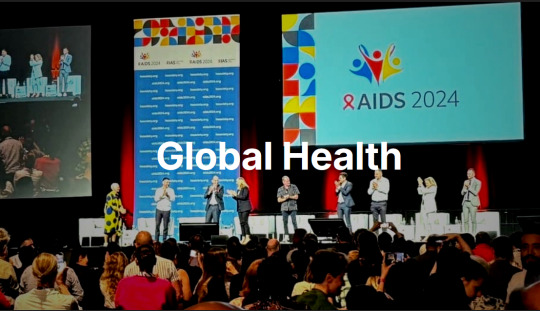
1. A game-changing HIV drug was the biggest story of 2024
In what Science called the 'breakthrough of the year', researchers revealed in June that a twice-yearly drug called lenacapavir reduced HIV infections in a trial in Africa to zero—an astonishing 100% efficacy, and the closest thing to a vaccine in four decades of research. Things moved quick; by October, the maker of the drug, Gilead, had agreed to produce an affordable version for 120 resource-limited countries, and by December trials were underway for a version that could prevent infection with just a single shot per year. 'I got cold shivers. After all our years of sadness, particularly over vaccines, this truly is surreal.'
2. Another incredible year for disease elimination
Jordan became the first country to eliminate leprosy, Chad eliminated sleeping sickness, Guinea eliminated maternal and neonatal tetanus, Belize, Jamaica, and Saint Vincent & the Grenadines eliminated mother-to-child transmission of HIV and syphilis, India achieved the WHO target for eliminating black fever, India, Viet Nam and Pakistan eliminated trachoma, the world’s leading infectious cause of blindness, and Brazil and Timor Leste eliminated elephantiasis.
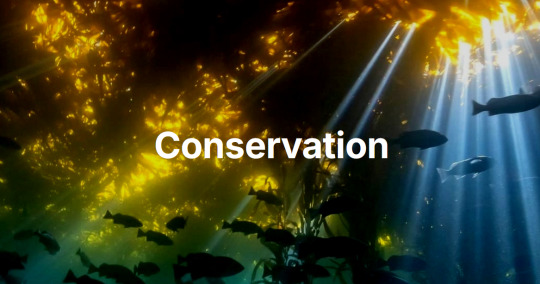
15. The EU passed a landmark nature restoration law
When countries pass environmental legislation, it’s big news; when an entire continent mandates the protection of nature, it signals a profound shift. Under the new law, which passed on a knife-edge vote in June 2024, all 27 member states are legally required to restore at least 20% of land and sea by 2030, and degraded ecosystems by 2050. This is one of the world’s most ambitious pieces of legislation and it didn’t come easy; but the payoff will be huge - from tackling biodiversity loss and climate change to enhancing food security.
16. Deforestation in the Amazon halved in two years
Brazil’s space agency, INPE, confirmed a second consecutive year of declining deforestation in the Brazilian Amazon. That means deforestation rates have roughly halved under Lula, and are now approaching all time lows. In Colombia, deforestation dropped by 36%, hitting a 23-year low. Bolivia created four new protected areas, a huge new new state park was created in Pará to protect some of the oldest and tallest tree species in the tropical Americas and a new study revealed that more of the Amazon is protected than we originally thought, with 62.4% of the rainforest now under some form of conservation management.
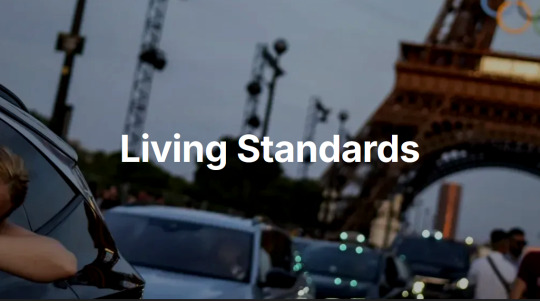
39. Millions more children got an education
Staggering statistics incoming: between 2000 and 2023, the number of children and adolescents not attending school fell by nearly 40%, and Eastern and Southern Africa, achieved gender parity in primary education, with 25 million more girls are enrolled in primary school today than in the early 2000s. Since 2015, an additional 110 million children have entered school worldwide, and 40 million more young people are completing secondary school.
40. We fed around a quarter of the world's kids at school
Around 480 million students are now getting fed at school, up from 319 million before the pandemic, and 104 countries have joined a global coalition to promote school meals, School feeding policies are now in place in 48 countries in Africa, and this year Nigeria announced plans to expand school meals to 20 million children by 2025, Kenya committed to expanding its program from two million to ten million children by the end of the decade, and Indonesia pledged to provide lunches to all 78 million of its students, in what will be the world's largest free school meals program.

50. Solar installations shattered all records
Global solar installations look set to reach an unprecedented 660GW in 2024, up 50% from 2023's previous record. The pace of deployment has become almost unfathomable - in 2010, it took a month to install a gigawatt, by 2016, a week, and in 2024, just 12 hours. Solar has become not just the cheapest form of new electricity in history, but the fastest-growing energy technology ever deployed, and the International Energy Agency said that the pace of deployment is now ahead of the trajectory required for net zero by 2050.
51. Battery storage transformed the economics of renewables
Global battery storage capacity surged 76% in 2024, making investments in solar and wind energy much more attractive, and vice-versa. As with solar, the pace of change stunned even the most cynical observers. Price wars between the big Chinese manufacturers pushed battery costs to record lows, and global battery manufacturing capacity increased by 42%, setting the stage for future growth in both grid storage and electric vehicles - crucial for the clean flexibility required by a renewables-dominated electricity system. The world's first large-scale grid battery installation only went online seven years ago; by next year, global battery storage capacity will exceed that of pumped hydro.
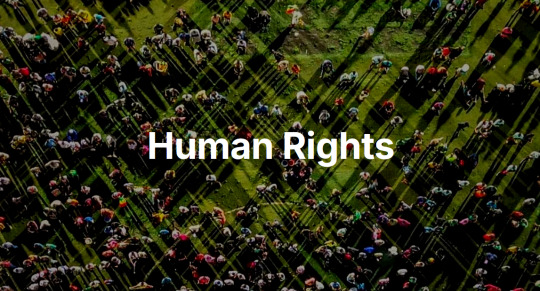
65. Democracy proved remarkably resilient in a record year of elections
More than two billion people went to the polls this year, and democracy fared far better than most people expected, with solid voter turnout, limited election manipulation, and evidence of incumbent governments being tamed. It wasn't all good news, but Indonesia saw the world's biggest one day election, Indian voters rejected authoritarianism, South Korea's democratic institutions did the same, Bangladesh promised free and fair elections following a 'people's victory', Senegal, Sri Lanka and Botswana saw peaceful transfers of power to new leaders after decades of single party rule, and Syria saw the end of one of the world's most horrific authoritarian regimes.
66. Global leaders committed to ending violence against children
In early November, while the eyes of the world were on the US election, an event took place that may prove to be a far more consequential for humanity. Five countries pledged to end corporal punishment in all settings, two more pledged to end it in schools, and another 12, including Bangladesh and Nigeria, accepted recommendations earlier in the year to end corporal punishment of children in all settings. In total, in 2024 more than 100 countries made some kind of commitment to ending violence against children. Together, these countries are home to hundreds of millions of children, with the WHO calling the move a 'fundamental shift.'

73. Space exploration hit new milestones
NASA’s Europa Clipper began a 2.9 billion kilometre voyage to Jupiter to investigate a moon that may have conditions for life; astronomers identified an ice world with a possible atmosphere in the habitable zone; and the James Webb Telescope found the farthest known galaxy. Closer to Earth, China landed on the far side of the moon, the Polaris Dawn crew made a historic trip to orbit, and Starship moved closer to operational use – and maybe one day, to travel to Mars.
74. Next-generation materials advanced
A mind-boggling year for material science. Artificial intelligence helped identify a solid-state electrolyte that could slash lithium use in batteries by 70%, and an Apple supplier announced a battery material that can deliver around 100 times better energy density. Researchers created an insulating synthetic sapphire material 1.25 nanometers thick, plus the world’s thinnest lens, just three atoms across. The world’s first functioning graphene-based semiconductor was unveiled (the long-awaited ‘wonder material’ may finally be coming of age!) and a team at Berkeley invented a fluffy yellow powder that could be a game changer for removing carbon from the atmosphere.
-via Fix The News, December 19, 2024
#renumbered this to reflect the article numbering#and highlight just how many stories of hope there are#and how many successes each labeled story contains#2024#good news#hope#hope posting#hopeposting#hopepunk#conservation#sustainability#public health#energy#quality of life#human rights#science and technology
3K notes
·
View notes
Text
DAY 6231
Jalsa, Mumbai Mar 9, 2025/Mar 10 Sun/Mon 1:17 am
The absence of routine gives the nerves a reclusive mind .. no rush to end the day in time for the time tomorrow .. no deadline to wake for the schedule and be in time for the prescribed mailed schedule from production ..
Pushing the hours to rest and slumber .. not entirely correct , but when the body desires there must be reason .. so a submission to the PRAB .. !!!!
PRAB ..
बूझो तो जाने !!??




... and the wellwishers .. in somewhat limited numbers and enthu, because of the IND v NZ .. but still a joy as ever ..
Sat in one spot .. sat in the style of the required टशन ... and the VICTORY !!
A cool calm collected play .. no facial giveaways of resolve or anxiousness .. just a most confident unobtrusive planned execution play ..
This is INDIA now in the eyes of the World .. a respect of achievement .. a recognition of India can do it .. an acceptance that India will do it ..
No more the insinuated '3rd World' tag .. no more the 'other' World in superiority .. we are the pride , we are the promise , we are the 'go to' nation .. we are the prime ..
Ravaged looted and ruled by invaders over hundreds of years ..
BUT in 78 yrs , of our fighting INDEPENDENCE .. teaching a lesson to the rest ..
How many other nations have achieved what INDIA has in 78 years of Independence ?
We rank high .. very high ..
Good night ..
And many congratulations to Team India for their Victory today 🇮🇳
My love

Amitabh Bachchan
106 notes
·
View notes
Text
Men fucking scare me.
Now, some are going to go like, "it's not all men", " Are you also scared of your dad/brother/male relative?", "Another 'feminist' hating on men" and so on probably. Sure, it's not all men but it's always men.
I was scrolling insta when I came across a reel where a guy is complaining about how whenever there is a crime concerning a woman, we raise our voice and protest yet when there is a crime concerning a man, there is barely even news coverage. Which is certainly true and fair. But seriously, right now? Why is it that men always complain whenever people are trying to give justice to a poor victim girl?? I totally agree that whether men or women, all victims should get their justice but have some fucking sympathy instead of complaining?!?
Next, another reel where a lawyer guy was talking about women's safety laws and all, the comments? "Law for women, la*da for men". Well, why don't you go and take a look at the statistics? Maybe read the news daily, I mean the local one. Again, I'm NOT against men's safety, ofc no. It's just that, why can't men complain or raise their concerns without pulling the women with them? What do you want? The laws that are made for us (not that they're REALLY useful) to go nil??? Or what?? Equality? That is feminism. Fucking equality!! You don't hear a true feminist complaining, "why do men get paid more than us? Salary for men, chillar for women" or anything, instead it's "We want to get paid the same as that of a man." Again, I'm NOT speaking against men particularly, just the ones who feel enraged towards us just because we want to get treated as a human first, and equally.
I was talking to a guy friend and his attitude is, "Yeah what happened to her is TERRIBLE but hey, it's not like I can do anything about that? I would never do that and be a good person but that's all I can do, I can't tell the rapists that what they did was wrong and they'd too be like 'oh yes yes oops we did wrong' right?". Now, I do understand his perspective but sure a bit more sympathy and kindness won't hurt anyone?? He even has a sister!! And in the age of social media, anyone with a phone can contribute to some extent.
When I read the details of the case, my soul cried out. I can't even imagine her sorrow. Oh my goodness. My insides felt all queasy reading those gruesome details. All girls of all ages have almost experienced a bad incident with men. Harassment, molestation, abuse, assault, SOMETHING! So many cases everyday and so many more which don't even get registered. Rapes have become so common in India that unless and until it's something very gruesome, people don't even bother that much. It's always "What has it got to do with me" until it's someone you, someone who is close to you. 78 years of independence yet girls are still caged behind walls.
It's always "Beti Bachao, Beti Padhao", Beti padh toh li lekin Beti bach nahi pai. Why is it always "Arre voh toh ladhka, voh toh aise he karega", Voh aisa kyu karega?!?
Why is that ladhkiyo ko mana karte hai raat mein bahar jaane ke liye because it's not safe for her, lekin ladhke puri raat awaaragardi kare, koi dikkat nahi.
Why can't we just teach boys to respect women? To not just respect women, but to respect everyone? The next person is a living being, is that not a good enough reason to not be cruel??
https://www.instagram.com/reel/C-ry4xNvZw0/?igsh=N2M0bW51c3dueGpi
Ajeeb toh hai.
#riri posts 💫#rg kar medical college#kolkata#india#desiblr#desi tumblr#women#so yes men do scare me#so much#what a blessing it is to be a woman until.#i love being a girl until.#desi people#desi academia#desi tag#another case#another victim#a cycle that keeps repeating#again after 12 years#when will we be free#when will we know peace#when will we finally be safe?#when will we be able to truly live...?#itna darr lagta hai#fir bhi muh se ek awaaz tk nhi nikal paati#itni ghutan hoti h!!!#it kills me from inside whenever my own family or society reminds me that I'm a woman so i can't do that or this#except i can#I'm just simply not allowed to#chained like a helpless animal#tw r4p3
169 notes
·
View notes
Text
Being a “centrist” sounds eminently reasonable, doesn’t it? A centrist is a moderate, right? Someone who is rational and practical and takes the middle ground. Someone who isn’t extreme like those crazy ideologues on the far right or far left. A centrist, logic dictates, is really what everyone should strive to be. But stop for a moment and ask yourself how you would define a centrist in more specific terms. When you start spelling out what the word really means, it becomes clear that it obfuscates more than it illuminates. The word does not describe a set of ideas so much as it reinforces a system of power. This, of course, is a feature not a bug of political language. As George Orwell wrote in his famous essay Politics and the English Language: “In our time, political speech and writing are largely the defence of the indefensible. Things like the continuance of British rule in India, the Russian purges and deportations, the dropping of the atom bombs on Japan, can indeed be defended, but only by arguments which are too brutal for most people to face, and which do not square with the professed aims of political parties. Thus political language has to consist largely of euphemism, question-begging and sheer cloudy vagueness.” Orwell wrote that essay in 1946. Today, 78 years later, it feels just as relevant. Look, for example, at the carnage in Gaza and the West Bank. Look at the statements from Israeli leaders that clearly suggest genocidal intent. Look at the tragedies that barely make a dent in the public consciousness any more. Last week, for example, an Israeli airstrike killed four-day-old twins, along with their mother and grandmother, when their father went to collect birth certificates in central Gaza. Look at the levels of brutality that barely seem to register any more: there is video evidence of the sexual abuse of Palestinians at a notorious Israeli military prison (though the more accurate term is “torture camp”) and, even with that evidence, we know there will be no real accountability. Look at the dead. Nearly 40,000 people in Gaza are now dead, including nearly 15,000 children. When you look at the scale of devastation, it seems likely that those figures are an underestimate. Further, counting the dead is excruciatingly difficult: kids are being blown into fragments so small that their surviving relatives have to collect pieces of them in plastic bags. Then there are the tens and thousands more who are now dying from starvation, or facing a looming polio epidemic. Look at the West Bank, meanwhile, where Israel has published plans for new settlements, which violate international law. Since 7 October, the Israeli army and settlers have displaced 1,285 Palestinians and destroyed 641 structures in the West Bank, according to the United Nations Office for the Coordination of Humanitarian Affairs. Ethnic cleansing is taking place before our eyes. Now look at how all of this is being justified. This war isn’t just being waged with bombs, it’s being waged with “euphemism, question-begging and sheer cloudy vagueness”. When you lay out what is happening in clear language, it is indefensible. So political language dresses all those dead and starving children up in euphemism. It obscures ethnic cleansing with vagaries. Don’t believe your eyes, political writing says. What you are seeing is far more complex than your eyes can possibly comprehend.
[...]
In order to defend the indefensible, politicians and political writers move away from concreteness, from clear language, and hide behind the respectableness of terms like “centrism”. Pro-Palestinian protesters are labelled the far-left or extremists. Continuing to unconditionally send arms to Israel and shield the country’s far-right government from accountability, however, is considered a centrist – and therefore reasonable – position.
[...]
As Orwell wrote, atrocities can be defended, “but only by arguments which are too brutal for most people to face, and which do not square with the professed aims of political parties”. If the Democratic party were to be honest about why it is doing very little to stop the carnage in Gaza and the settlements in the West Bank, the bluntest argument would be along the lines of: “Israel is an important tool in maintaining US imperialism and western interests. The ethnic cleansing of Palestinians is expedient to those interests. Human rights law doesn’t apply to atrocities enabled by the west.” Of course, being pro-ethnic cleansing doesn’t quite square with the do-gooding branding of the Democratic party. Instead, we are bombarded with the idea that massacring children is somehow a centrist and moderate position.
22 August 2024
133 notes
·
View notes
Note
Men are struggling and fighting for the safety of your nation and yet ungrateful females like you have reasons to believe that you are not safe. R@pe cases are rare in India compared to other countries and many cases are fake. Whenever a man is accused of a false r@pe, nobody pays attention because our pain is not considered a pain. Women show their cleavage, roam at night with their boyfriends, cheats on their partners and believe that they deserve to be treated with respect. A man is not even treated properly if he doesn't bring anything to the table .... Goahead blame men shamelessly but remember you get independence because of men only 😕
78 years of independence. independence from what? what safety?women are in a constant state of vigilance, like a country on terrorist alert. no democracy is a democracy when half its population lives in fear. this cultural agreement that women have little value. which means in turn that girls must be trained to act as if they do not exist, to minimise their presence to survive, to serve men and not inconvenience them. this is how India treats women. the man worshipping is sky rocketing, women crippling other women down is the highest level of patriarchy. no environment, no territory, no generation is spared the violence done to women. from the moment we enter crying to the moment we leave dying, if youre a woman that is your biggest crime. we speak up, they try to shoot us down. we exist, they try to burn us alive. yes i am dehumanizing men, because it wasnt a woman who tore that girl limb from limb left her mouth and eyes bleeding alike. men dont care about other men, men dont care about other women. if you feel offended, you are part of the problem. you need to be locked up or you need to change. yes i am dehumanizing the government because only some kind of monster could overlook hate crimes as such.
not everything is about men. why are you so entitled to raise your voices louder when women raise their voices loud. it's not a competition, if you have issues, raise them. don't you think it's ironical and hypocritical to raise awareness about "internalized misandry" only after a heinous crime such as this has taken place? men dont care about other men or they would be out on the streets demanding the government for justice. if women are misandrists, speak against it. but now is not the time to do that, this is not the time to highlight the faults of women.
110 notes
·
View notes
Text
What Is Tarot?
— an educational post



— ⭑.ᐟ I am aware many people have made posts like this before, however I still felt like creating my own take on it. What inspired me was a post where someone stated that tarot is fictional. Which is incredibly incorrect. Being misinformed is of course, fine, but they said it with such utmost arrogance and confidence that it annoyed me a little. If you are misinformed, not even educated on tarot as a whole, what gives you the right to be a tarot reader? You cannot guide people if you, yourself are wrong and have incorrect information and assumptions. That is what I would have liked to tell them, but unfortunately due to my then circumstances I did not. I also would like to follow the word of God, and He says to act with love, not hatred. So, instead of calling them out and possibly causing an unnecessary argument, I have decided to educate those who might be curious or confused about what tarot actually is as a whole. It’s your choice if you read this or not. I also won’t go into themes of religion, this will strictly be focused on tarot. I just wanted to share what’s on my mind. not proof read.
what is tarot?
Actually, my dearest, tarot was created in the 1430s - 1450s and was first called tarocchi. It’s a game similar to bridge.
They were created in Northern Italy, Milan. Although at the time it was a game, it was still considered a luxury. The cards were hand painted for wealthy people, not necessarily due to them finding joy in it, but rather to reflect their status. It was a symbol of being wealthy.
Although nowadays the standard of a tarot deck is 78 cards it started off with 56 cards, from which the fool was the odd one out, a wild card. - If you have a hard time understanding, think of the joker card from solitaire. -
It was only used as a form of divination at the beginning of the 18th century, aka the 1700s.
Now, there are several reasons whys this has happened, but I will try my best to explain it to you in simple terms. - Although I won’t be able to go into every detail as these topics are very complex and have a rich history behind them, so please keep that in mind. -
In the early 1700s French occultists made claims about their meaning and history. They were confident in their skills, abilities and knowledge. Due to them grabbing people’s attention this led to people making custom cards for the usage of cartomancy.
At these times Romani and Sinti people were heavily discriminated against. They weren’t allowed to settle, work, buy a house and were banned from most public spaces including ones where one can buy food and such. All because they originated from India. So, as a means to keep alive they turned to earning money with divination, creating opportunities for themselves in order to live.
Another reason for tarot in a form of divination becoming popular is due to conservative Christian’s spreading the misinformation of it being related to Kabbalah, the Jewish mystical tradition. Of course, that is not true, never was and never will be. However, they are said to have some parallels. That is as far as it goes though.
Now, you could be thinking to yourself, ‘if it was a game, then it’s not a real divination.’ You are wrong! Let me explain to you why!
Remember how I mentioned that originally it had 56 cards and was named tarocchi? It also originated in the 15th century. The tarot you know of today began in the 18th century, got popular in the 19th century. There is roughly about 300 years between the two events and tarot has evolved for 100 years. So one can argue they are completely different things. Even if they are not, that’s alright.
Objects created for non divination usage can still be used for divination despite the creator’s intent. I will present you with a few examples of this fact.
Some people use their passed on pet’s bones as a form of osteomancy. You throw em, if they touch it’s a yes, if they don’t it’s a no. Sounds pretty messed up, right? For some people at least, can’t guarantee everyone thinks the same. Regardless, that was a living being, a beloved pet. Yet, you can use it’s bones in order to practice spirituality.
If you watch youtube pick a cards this will be easier to understand, regardless, charms can be used as a form of divination. You draw different categories on a paper, throw charms at them, whatever it falls on will have a meaning to your question. Money charms on ‘future spouse’? They might as well be wealthy, or at least good with their money.
Or, if that’s not good enough think about witchcraft. You think every single little thing used for spells, jars, hexes and so on was created for the sole purpose of witchcraft? It wasn’t. Yet it works because it’s intentional, because the person doing them has talent for it, because they were gifted.
how do readers read tarot cards?
I will be honest with you, not all readers are gifted with being able to do so, but they sure believe they do. - Am I saying this out of pettiness? Perhaps, let me be. -
So, if you feel like something is off such as beating around the bush, being too nice, being too mean and so on please trust your gut. Not telling you to be mean to people or accuse them unprovoked, that’s something an @sshole does, and I know you are not one. - Watch out for AI readings though, they suck. -
Moving on, I would like to say that every single tarot reader reads their cards differently. Some only do by visuals, some only does so by meaning, some do by both!
Alongside this, every reader shuffles differently. Some let the cards fall out, some take whatever is on top, some take whatever is standing out of the deck, some let them fall and then organise them neatly.
There is many ways to do this. I personally let them fall out and consider both visuals and meanings simply because I believe that is the right thing to do. - One time, during a love reading they fell out in a heart. I thought that’s cute. - At the end of the day, it doesn’t matter much. I have had several friends with different methods than me give me really good and accurate readings. - Just be catious of people who spread it out and then pick the cards out themselves. -
The most important part is being gifted with claircognizance, or in other words having hella good intuition. - or “6th sense”, whatever you wanna call it. - I believe every reliable and accurate reader is gifted with this, regardless of them being aware or not. You can’t read tarot if you don’t understand what spirit is trying to tell you, let that be your own guides or anyone else’s. Perhaps even your tarot deck.
Often times though, this is not the only thing readers rely on. For instance, I have clairaudience, clairvoyance and clairtypity. I can hear, see and feel what you would during whatever situation I read for you. This is not unique to me at all, every reader has at least one of these, and usually several. I even saw people with clairgustance and clairalience! They can taste and smell what you would! Isn’t that awesome?~ I personally think it’s fascinating, it’s not something that I have ever experienced. It’s cool that there are people out there who can do this.
So, tarot readers read your situation with the help of your spirit guides and their own spiritual gifts that they carry within themselves. As for habits and methods, it varies from person to person.
That is a reason why so many different tarot decks exist! Different people are called to different things. - Plus it’s cool -
how do tarot readings work?
This is the main reason why this post was made.. let’s get into it.
You already know how readers guide you, so I will tell you how do the readings themselves work. What else are they based on. Honestly, the best way I will be able to tell this to you is with examples, so that’s what I will do. Maybe someone else can tell you in a much more detailed and specific manner, but I am not them.
Tarot always reads your current energy. You can look into the past with it, but regardless it reads your current state of mind, thoughts, views, feelings and behaviours.
If you read a pick a card or personal reading that is based on the future - ex.; future spouse - then it will still read on your current energy.
For example let’s say you ask ‘when will I meet my future spouse?’ but you stay inside all day, then it will obviously be a few years or so. However, if the next day you decide to go out more or just put yourself out there in the world more and actually commit to it this can reduce to months.
If it’s a reading on your past then the cards will pick up on what still impacts you, whether you are aware of it or not. Let’s say you ask about your first kiss, how will it be like? Your cards could say that it won’t be as romantic as you think because this and that situation still impacts you.
I sincerely hope that you get the point, as I did my best to explain it.
Yet, there is still a question, ‘if someone is talented, why did that one reading turn out inaccurate?’ well because things change my dear.
If you were to ask me now about the appearance of your future spouse I could say they have brown hair and be correct, but they could go ahead and dye it red 15 minutes after I said that.
Things change constantly all the time and there is nothing we can do about it. That’s just life. It’s hard to hear, it’s hard to swallow, but it’s something we have to accept at some point in time. We can control some things, but not everything.
Change is inevitable.
There is good sides of it, and there is bad. You just gotta live and let others do the same.
Now, for pick a cards it’s slightly different. Maybe, genuinely, something is just not meant for you and you are just meant to ignore that. Maybe it’s for the blond teen in Canada who is asking about that one cute boy in her class. If you read a pick a card reading that is accurate but there is that one thing that doesn’t make sense, consider that means something to someone else. It’s not a personal reading.
That is why disclaimers like ‘take it with a grain of salt’ and ‘leave what doesn’t resonate’ exist. Yes, some people take advantage of it and that’s bad, but they were created with a good reason.
end note.
That is all I wanted to say, I believe. Although I made this post to get something bothersome off my mind I sincerely wish that someone out there has found it useful. My goal was truly to educate so if you know who the OP of the claim was just ignore them. Hating on people for enjoyment is not only immature but is going to have a negative effect on your body, mind and soul. Which I would not like. Please take care of yourselves! Thank you for reading.
#I made this out of pure spite#tarot#tarotblr#tarot community#tarot commissions#tarot reading#tarot cards#tarot blog#tarot decks#free tarot reading#paid tarot#spirituality#free tarot#astroblr#paid readings#pick a card#pick a picture#astro community#astrology
70 notes
·
View notes
Text

Princess Alice, Grand Duchess of Hesse (1843-1878)
Artist: Joseph Hartmann (German, 1812-1885)
Date: 1879
Medium: OIl on canvas
Collection: Royal Trust Collection, United Kingdom
Description
Princess Alice (1843-78) was the third child and second daughter of Queen Victoria and Prince Albert. Known for her sweet nature, she often took on the role of peacekeeper in the royal household. The marriage of her older sister, Princess Victoria, in 1858 left Alice as the eldest daughter at home, and the Queen and Prince Albert both turned to her for company. In a popular edition of Alice's letters to the Queen, published in 1885, Princess Helena, her sister, described her as ‘loving Daughter and Sister, the devoted Wife and Mother, and a perfect, true Woman’. In 1862 she married Louis IV, Grand Duke of Hesse.
In this portrait the Princess appears in evening dress with the badges of the Orders of Victoria and Albert, the Crown of India, and Louise of Prussia.
#portrait#princess alice#grand duchess of hesse#british royal family#half length#evening dress#badges of the orders of victoria and albert#crown of india#crown of louise of prussia#brooch#pearl necklace#pearl earrings#collar#german art#painting#oil on canvas#german painter#fine art#oil painting#european art#british history#house of hesse#house of windsor#joseph hartmann#19th century painting#royal collection trust
40 notes
·
View notes
Text


Today marks the day a legend was born. Freddie Mercury, the late singer of the rock band group Queen.
Had he survived, he would have been 78 years old today.
Born September 5th, 1946, Farrokh Bulsara (also known as Freddie Mercury) in Zanzibar to Parsi parents from India. When the Zanzibar Revolution happened in 1964, he and his family fled to England. Having studied and written music for years, he formed Queen in 1970 with guitarist Brian May and drummer Roger Taylor.
His legendary performance at Wembley Stadium for Live Aid in 1985 remains one of the most enduring images of Mercury as a 72,000 strong audience sang and clapped in unison, and has been hailed as one of the greatest moments in rock history.
Freddie could sing at a range of five octaves, and boasted a powerful voice to match.
He constantly pushed the boundaries of music and perception, becoming an idol to many.
He died November 24, 1991, at the age of 45, from complications of AIDS, literally 24 hours after he finally announced he had it.
He will never be forgotten.
36 notes
·
View notes
Text
78 years of independence,but are we really free?The sacrifices of our girls continue to haunt me.In India, a woman is raped every 20 minutes, yet the laws remain weak. From a doctor after a 30-hour shift to a kindergartener in a van, the horrors are real. Can't imagine how much pain she would have went through. She would have been asking help from God, was thinking about her parents, was hating the idea of attending extra night duty. At the stroke of midnight, when the men are asleep, women of this country are awake & protesting on the streets for their right to justice & freedom.
They said: "beti bachao, beti padhao" but "beti padhi par baachi nahi"
#desiblr#desi tumblr#desi stuff#desi tag#desi things#desi humor#desi people#being desi#desi shit posting
36 notes
·
View notes
Text
COLOSSAL
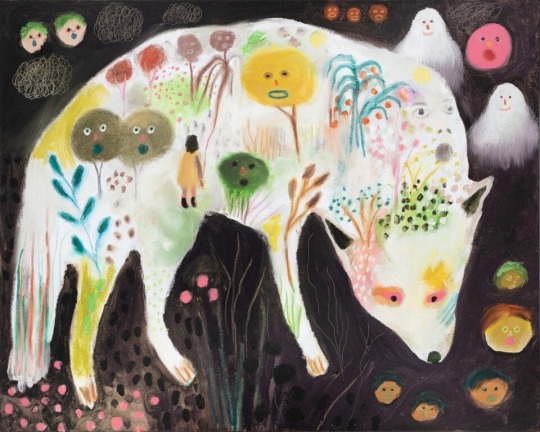
“Unearthing Buried Gods.” Michael McGrath
Michael McGrath Summons Symbolism and a Folk Art Style in Expressive Paintings
November 6, 2024
Art
Kate Mothes
From fanged cats and all-seeing ravens to anthropomorphized botanicals and disembodied faces, Michael McGrath’s uncanny works nod to the symbol-rich, flat compositions of folk art or “naïve” painting. His mixed-media works combine materials like graphite, oil paint and oil stick, ink, and acrylic on a variety of surfaces, including wood, canvas, and burlap.
Inspired by the expansive scenes of contemporary artists Peter Doig and Mamma Andersson, and self-taught artists Henry Darger (1892-1973) and William Hawkins (1895-1990), McGrath harnessed a narrative approach in his own practice. “I decided to experiment with figures and storytelling in my painting,” he tells Colossal. He also counts Jim Henson among his influences.
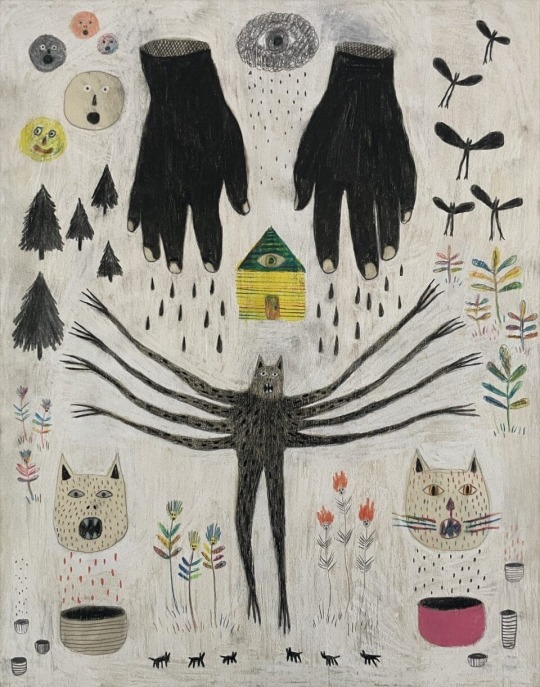
“Threats and competition for tiny vampires” (2023), graphite, colored pencil, and India ink on wood panel, 14 x 11 inches
Populated with an array of characters, from trees with alarmed expressions to tiny, fairy-like black critters with bulbous wings and long legs, McGrath delves into mysterious, emotional tales with plots as enigmatic as they are supernatural.
The artist’s interest in painting evolved from an early fascination with design, especially album covers and advertising in magazines like Spin and Thrasher. “I never had the patience to develop classical skills, so I focused on dimensional and collage work for a while, until I eventually decided to invest more time in painting,” he says.
McGrath’s work will be part of an online group show with MePaintsMe, Slight of Hand, which opens on November 12. In February, he will also have pieces on view in a group show at Court Tree Collective in Brooklyn.
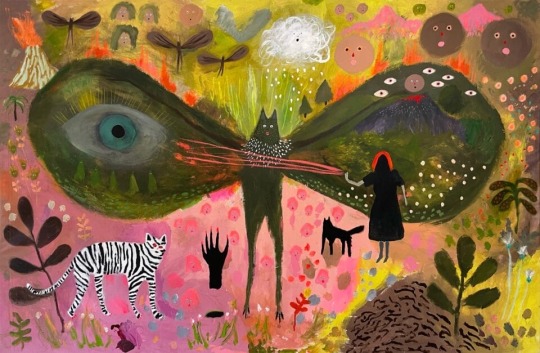
“Monster control, future systems No. 3,” (2024), acrylic, oil stick, and oil on canvas, 78 x 120 inches
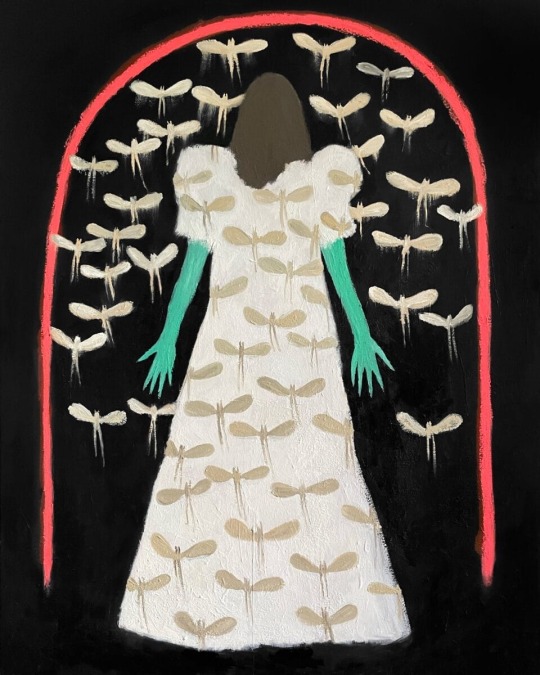
“Night float, threat window” (2024), oil and oil stick on canvas, 60 x 48 inches

“Hunting songs” (2024), oil, oil stick, and grease pencil on linen, 30 x 24 inches
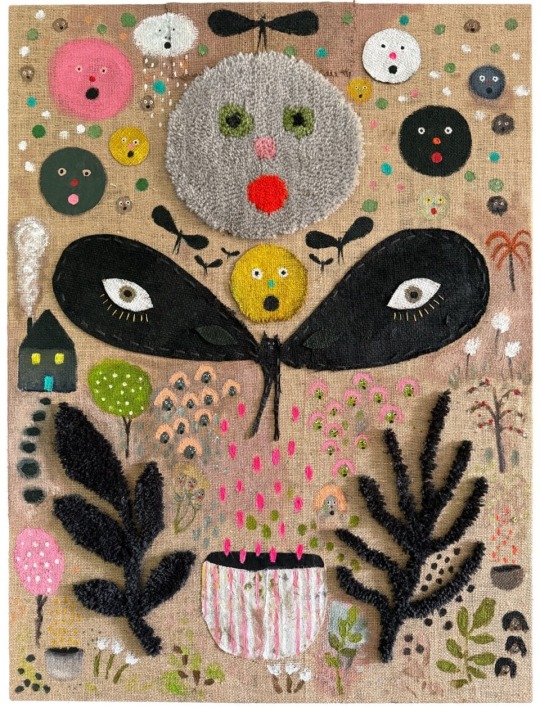
“Muppet moon nightmare choir” (2024), acrylic, acrylic yarn, embroidery thread, painted canvas, and burlap on burlap, 40 x 30 inches
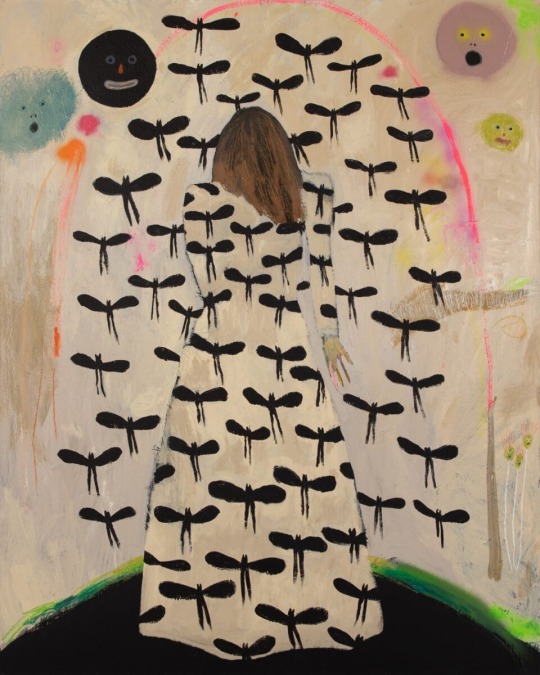
“Moon float” (2024), acrylic, watercolor crayon, enamel, and oil pastel on canvas, 60 x 48 inches
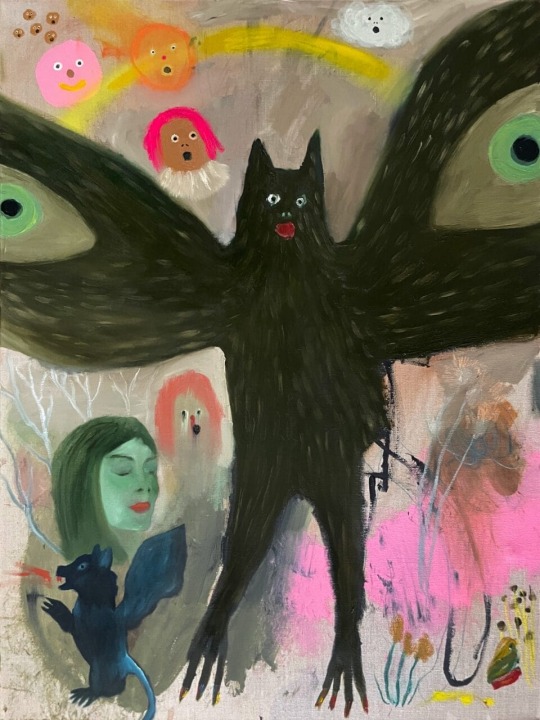
“Stories to frighten your children with and dangerous literature” (2023), oil, oil pastel, and acrylic on linen, 30 x 40

“Cat song, moon riot, No. 2” (2024), oil on canvas, 48 x 36 inches
#colossal#Michael McGrath#Summons Symbolism and a Folk Art Style#in Expressive Paintings#November 6 2024#Art#kate mothes#anthropomorphized botanicals and disembodied faces#compositions of folk art or “naïve” painting#His mixed-media works combine materials like graphite oil paint and oil stick#ink#and acrylic on a variety of surfaces#including wood canvas and burlap#Inspired by the expansive scenes#contemporary artists Peter Doig and Mamma Andersson#and self-taught artists Henry Darger (1892-1973)#and William Hawkins (1895-1990)#McGrath harnessed a narrative approach in his own practice#artist painter#original art#art work#art style#art colors#ilustration painter#ooctoopussy#xpuigc#xpuigc bloc
13 notes
·
View notes
Text
Solo Leveling Ragnarok arcs:
Campus breakout: chapters 1-5
Goblin time: 6-8
Raikan's sword/Gwanak Mount Field Arc: 9-13
Hyena Arc: 14-20
Seul Station Field/Demon factory: 21-30
Magok Field/Beast Sanctuary Arc: 31-37
Retest C rank/Manager Kim: 38-40
Paju Field: 41-44
Pyramid Arc: 45-56
Times Square Field Arc: 57-70
Insect Sanctuary Arc: 71-77
Recruitment Arc: 78-84
Demon Realm Arc: 85-106
Preparation Arc: 107-116
Glacier Dungeon Arc: 117-136
Jisan Prison Break Arc: 137-156
Woojin guild Arc: 157-162
Busan Haeundae Beach Dungeon Break Arc: 163-173
Black Market Arc: 174-199
Asura Guild/India Arc: 200-221
Hunter Association/Second retesting Arc: 222-234
Seo Jiwoo double dungeon/ Hapjeong Station Arc: 235-237
Demon King's trial Arc: 238-243
Sea of Afterlife /World Tree Arc: 244-252
North Korea Arc: 253- onwards
#solo leveling ragnarok#solo leveling#sung suho#solo leveling ragnarok light novel#solo leveling ragnarok manhwa#still needs a bit of fixing but use it as a bonus guide if you wish
19 notes
·
View notes
Text

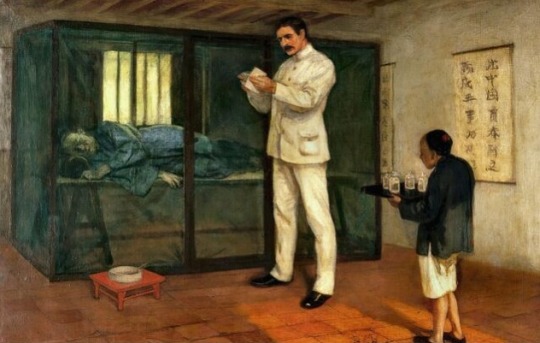



Scottish physician Patrick Manson was born in Oldmeldrum in Aberdeenshire on October 3rd 1844, he is regarded as founder of the field of Tropical Medicine.
Patrick Manson was a son of Alexander Manson and Elizabeth Livingstone Blaikie, his dad was the manager of the local Linen Bank, and Laird of Fingask. His mother was distant relative of the famed Christian missionary-explorer David Livingstone.
He developed a childhood passion in natural history, fishing, shooting, carpentry, mechanics and cricket. Among his Presbyterian-Christian family, he showed excellent memory for memorising church sermons at the age of 5 years. In 1857 his family moved to Aberdeen, where he started his formal education at Aberdeen’s Gymnasium School and continued at West End Academy.
Aged 13 1859 he was apprenticed to Blaikie Brothers “Iron masters” however struck down by a form of tuberculosis he had to leave this job, the ironworks loss would be medicines gain, a year later he entered Aberdeen University where he completed medicine course in 1865 however aged only nineteen and was underage for graduation, so he visited hospitals, museums and medical schools in London. Finally of age he formally graduated in October 1865, and was appointed Medical Officer at Durham Lunatic Asylum.
The following year he gained his Master of Surgery and his Medical Doctorate.
Immediately after qualifying Manson travelled to Formosa (now Taiwan) to take up a post as a medical officer to the Chinese Imperial Maritime Customs. In 1871 he transferred to Amoy, on the Chinese coast, and 13 years later he moved to Hong Kong, where he practiced from 1883 to 1889. Manson developed an early interest in tropical diseases, and in particular in the role of parasites in their transmission. His initial studies were on filaria, a small parasitic worm that causes elephantiasis: and he was able to show that mosquitoes had a key role in transmitting the worms and spreading the disease.
Manson’s discovery helped inform the work of Sir Ronald Ross, who was studying the transmission of malaria in India at the time. While in Hong Kong, Manson helped found the Hong Kong College of Medicine for Chinese, which later formed the nucleus of the University of Hong Kong. He was also the first person to import dairy cattle from Scotland to Hong Kong, starting a dairy industry there supplying hygienic milk affordable by pregnant women, children and patients.
Manson moved to London in 1889 and in 1897 was appointed to the post of Chief Medical Officer to the Colonial Office. Amongst his early initiatives was the foundation of the London School of Hygiene & Tropical Medicine, which opened in 1899. He was elected to the Royal Society in 1900, knighted in 1903 and in the following year awarded an honorary Doctorate of Science by the University of Oxford. In 1907 he became the first president of the Royal Society of Tropical Medicine, and retired from the colonial office in 191
Retiring in 1912 to fish in Ireland Manson returned to London at the beginning of the First World War. Despite crippling attacks of gout he continued to take a lively interest in medical education.
He died in London in 1922 at the age of 78 and is buried at Allenvale Cemetery in Aberdeen.
11 notes
·
View notes
Text
Bangladesh's parliament has been dissolved, a day after prime minister Sheikh Hasina was forced from power.
Ms Hasina resigned and fled the country after weeks of student-led protests spiralled into deadly unrest.
The dissolution of parliament, a key demand of protesters, paves the way for establishing an interim government.
Bangladeshis are waiting to see what comes next, as the country's military chief is holding talks with political leaders and protest organisers.
According to local media, more than 100 people died in violent clashes across Bangladesh on Monday, the single deadliest day since mass demonstrations began.
Hundreds of police stations were also torched, with the Bangladesh Police Service Association (BPSA) declaring a strike "until the security of every member of the police is secure".
The group also sought to place the blame at the door of authorities, saying they were "forced to fire".
Overall, more than 400 people are believed to have died, as protests were met with harsh repression by government forces.
The protests began in early July with peaceful demands from university students to abolish quotas in civil service jobs, but snowballed into a broader anti-government movement.
Weeks of unrest culminated in the storming of the prime minister's official residence, not long after Ms Hasina had fled to neighbouring India, ending nearly 15 years of rule.
Bangladeshi leaders are under pressure to establish an interim government to avoid a power vacuum that could lead to further clashes.
Within hours of her resignation, Bangladesh's army chief Gen Waker-uz-Zaman pledged that an interim administration would be formed, adding on state television that "it is time to stop the violence".
Student leaders have been clear they will not accept a military-led government, pushing for Nobel Peace Prize winner Muhammad Yunus to become the interim government's chief adviser.
Mr Yunus, who agreed to take up the role, said: “When the students who sacrificed so much are requesting me to step in at this difficult juncture, how can I refuse?”
He is returning to Dhaka from Paris, where he is undergoing a minor medical procedure, according to his spokesperson.
Meanwhile, ex-prime minister and key opposition leader Khaleda Zia was released from years of house arrest, a presidential statement said.
She chairs the Bangladesh Nationalist Party (BNP), which boycotted elections in 2014 and again in 2024, saying free and fair elections were not possible under Ms Hasina.
The BNP wanted the polls to be held under a neutral caretaker administration. This has now become a possibility after the departure of Ms Hasina, who had always rejected this demand.
Ms Zia, 78, served as prime minister of Bangladesh from 1991 to 1996, but was imprisoned in 2018 for corruption, although she said the charges were politically motivated.
She was not the only opposition figure to be released after years of detention.
Activist Ahmad Bin Quasem was also released from detention, according to his lawyer Michael Polak.
Rights groups say Mr Quasem was taken away by security forces in 2016, just one of hundreds of forced disappearances in the country under Ms Hasina's rule.
"There were many points during his detention that he was feared dead, and the uncertainty was one of the many tools of repression utilised by the regime," Mr Polak explained, adding they hoped the decision to release political prisoners "is a positive sign of their intentions".
"Unfortunately, the good news won’t be shared by all," he told the BBC, stating that a number of political prisoners had died in custody.
At least 20 other families of political prisoners gathered outside a military intelligence force building in the capital Dhaka earlier in the day, still desperately waiting for news about their loved ones, AFP news agency reports.
"We need answers," Sanjida Islam Tulee, a co-ordinator of Mayer Daak (The Call of the Mothers) campaign group, told the news agency.
Across the border in India, Foreign Minister S Jaishankar said he was "deeply concerned till law and order is visibly restored" in Bangladesh, with which India shares a 4,096-km (2,545-mile) border and has close economic and cultural ties.
He gave the first official confirmation that Ms Hasina made a request to travel to India at "very short notice" and "arrived yesterday evening in Delhi".
India also deployed additional troops along its border with Bangladesh.
"Our border guarding forces have also been instructed to be exceptionally alert in view of this complex situation," Mr Jaishankar said.
14 notes
·
View notes
Text
Pratap and Ajabde are entirely coded as “she fell first but he fell harder.”
Their love for each other is constant, endless and selfless, but this guy literally does a 180 when it comes to Ajabde.
(Yes Maharana Pratap is foremost a desh bhakt and a warrior, but warriors have some of the most sensitive and beautiful hearts filled with love.)
P.S. yes. This post is a way to distract myself from more horrific news I have read today; the day India got Independence 78 years ago.
@yehsahihai @ahamasmiyodhah
#maharana pratap#maharani Ajabde#ajabde#pratap#praja#Bharat ka veer Putra Maharana pratap#love#she fell first he fell harder#they are all tropes and yet one trope#unique love#endless#constant love#alamelu rambles
10 notes
·
View notes